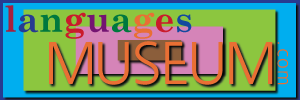
 |
Give a man a match, and he'll be warm for a minute, but set him on fire, and he'll be warm for the rest of his life.UU |
Language Museum
Welcome to the Language Museum. Feel free to browse the hallways and take in the exhibits. If you are someone who likes learning foreign languages you will feel very much at home here. The museum will not teach you how to speak a language per se, but it will give you insight into the relationships between different languages, and show you that it is not hard to learn another language if you already know a related one. This website was inspired by the book The Loom of Language, which was written by the linguist Frederick Bodmer in 1944. Bodmer envisioned the "Language Museum" as a physical museum where lists of words in various languages would be put on display. I have taken his orginal idea and realized it in cyberspace. Also I have expanded his original word lists, which were limited to European languages, to include languages from around the world. My intention is to show people, especially English speakers, that learning foreign languages is not as difficult as it seems. If you study these word lists, you will see the similarities between basic terms in related languages. After a while, you should start to see patterns. For example, words starting with the letter "t" in German often start with the letter "d" in English (such as Tur and door). Also, the initial "d" sound in German often corresponds with the English "th" (drei and three). These are called regular sound correspondences, and they are what linguists look for when comparing languages that are possibly related. Word pairs in different languages that are derived from the same source, such as Tur/door and drei/three are called cognates. But it is important to remember that unrelated languages can also share cognates because of borrowing. I have chosen only the most basic vocabulary items for these tables. Linguists like to compare basic words, such as pronouns, parts of the body and numbers, because they are more "stable," or resistant to borrowing. Please Note: If you are using an older browser, some characters may not display correctly.
|
|||||||||||||||||||||||
Home
Algonquian
Altaic
Austronesian
Germanic
Japanese Korean Cognates
Romance
Sino Tibetan
Uralic
Uto Aztecan
|
   |
||||||||||||||||||||||
| LanguagesMuseum.com |
Site Map |
Terms of Use |
Privacy & Security |
Contact Us |
Purchase Agreement |
Send Feedback |